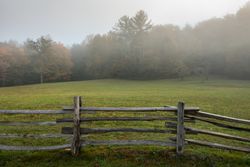
Split-rail fences are simple, rustic-looking wooden fences traditionally made from timber logs split lengthwise into rails. This American classic offers many pros and cons for owners looking for a way to define their property lines or simply improve the appearance of their yard. If you’re trying to decide if a split-rail fence is the best option for your needs, the fencing experts at All American Fence in New York have compiled this information to use as a guide.
Guide to Split-Rail Fences
Common Uses
Split-rail fences are traditionally used to keep animals corralled and to let others know where property lines begin and end. They’re common on farms and ranches, but they’ve grown in popularity in residential areas in recent years.
Pros
 Because these fences are simple in their design, they’re generally the most affordable fencing choice available. They’re also easy to install and repair. Modern split-rail fences are built in either wood or vinyl and can also be used for decorative purposes. Vinyl fences are especially easy to clean, and wooden fences made from hardwoods are also durable when properly maintained.
Because these fences are simple in their design, they’re generally the most affordable fencing choice available. They’re also easy to install and repair. Modern split-rail fences are built in either wood or vinyl and can also be used for decorative purposes. Vinyl fences are especially easy to clean, and wooden fences made from hardwoods are also durable when properly maintained.
Cons
Although some options are affordable, the type of material used can also make split-rail fencing one of the more expensive options. High-quality hardwoods will drive the price up, and those heavy materials can also raise labor costs. Wood materials also need regular treatment to prevent decay and deterioration. This type of fencing is open and loose, and small pets and children can easily escape through them.
The experienced team at All American Fence has helped residents in Rochester, Corning, Geneva, and Batavia, NY, as well as the surrounding area with their fencing needs for more than 30 years. If you’d like to learn more about split-rail fences and whether it’s right for your home or business, one of their experts can answer your questions and help you find the right solution. Call (585) 352-8370 for a free estimate, or visit them online to learn more.
About the Business
(1 reviews)
Have a question? Ask the experts!
Send your question

